Effect of Rubber Granulate Content on the Compressive Strength of Concrete for Industrial Vibration-Isolating Floors
Abstract
1. Introduction
- -
- Context and motivation—Increasing importance is being attributed to vibroacoustic comfort in industrial environments, especially in facilities with sensitive equipment or automated processes. Traditional vibration-isolating solutions (e.g., elastomer mats) are often expensive, difficult to install, and prone to degradation.
- -
- Integrated damping layer concept—A composite floor system is proposed, where a 5 cm-thick damping layer made from rubber granulate-enhanced mortar is cast beneath a standard reinforced concrete slab. This layer replaces conventional insulating materials with a monolithic, construction-friendly solution.
- -
- Material selection and mix design—Rubber granulates (EPDM and SBR) were used to partially or fully replace natural aggregate in subbase concrete and mortars. Mixtures were tested for workability, consistency over time, and compressive strength to ensure suitability for structural use.
- -
- Laboratory and pilot-scale testing—Both lab-scale mechanical tests and in-situ dynamic testing of full-size slabs under controlled vibration (using the Mark IV vibroseis system) were performed. Three floor variants were compared: reference (no damping layer), EPDM-only, and EPDM + SBR hybrid.
- -
- Effectiveness of vibration isolation—Significant reduction in vertical accelerations (Z-direction) was observed: 45.5% for the EPDM layer and 58.6% for the EPDM + SBR hybrid layer.
- -
- Practical implications—The proposed solution enables vibration isolation to be built directly into concrete floor systems using recyclable materials. The mixes showed stable consistency, good self-compacting behavior, and compatibility with standard production methods, suggesting strong potential for real-world application.
2. Materials and Methods
2.1. Reference Mixture
- compressive strength class: C8/10 to C16/20;
- target layer thickness: 15 to 40 mm, which determined the maximum aggregate size (Dmax = 8 mm);
- consistency class: S4/S5 (i.e., slump ≥ 200 mm), maintained for at least 60 min, with the required self-compacting ability of the mix.
- −
- To improve the vibration isolation capacity of the concrete layers, the following materials were selected as modifying additives (Figure 1a,b): rubber EPDM granulates (1/3 mm fraction) and SBR granulates (0.8/2 mm fraction).
- fresh concrete density (according to [25]).
2.2. Self-Compacting Subbase Concrete Mixtures
3. Results
3.1. Results of Material Property Tests of Concrete Mixtures
3.2. Results of In-Situ Dynamic Testing
4. Discussion
5. Conclusions
- Functionality and safety are essential in high-demand environments, considering mechanical, chemical, and environmental factors. Concrete is strong and cost-effective, but evolving needs for better vibroacoustic performance drive innovation. Rubber granulates in cement layers improve vibration isolation but require balancing structural strength.
- Integrating vibration-damping properties into mortar with recycled rubber granulates surpasses traditional systems, promoting sustainability and multifunctional design. Research supports developing advanced floors that balance structural performance with enhanced comfort and adaptability.
- A reliable subbase concrete mix meeting technical and performance requirements was developed, combining ground granulated blast furnace cement, siliceous fly ash, and a polycarboxylate-based admixture. A strength reserve was included to counteract reduced mechanical performance from the rubber granulates.
- Incorporating EPDM and SBR rubber granulates maintained good workability and self-compacting properties, even with 100% natural aggregate replacement. The suitability was validated through consistency and compressive strength tests, confirming vibration-damping performance.
- Full-scale production and testing confirmed compliance with EN 206 [21] standards and project-specific requirements. Both mixes showed excellent workability, pumpability, and consistent performance. Compressive strength exceeded the required thresholds, demonstrating durability and reliability.
- Mortars with EPDM and hybrid SBR–EPDM rubber granulates were produced at a ready-mix plant. Required flow properties were maintained, and target compressive strengths were achieved after curing, confirming technical feasibility and practical applicability.
- Construction and dynamic testing of floor slabs confirmed feasibility and effectiveness. The mixes met the structural and dimensional requirements, with a significant reduction in vibration transmission, especially in the vertical direction.
- The slab with hybrid EPDM/SBR rubber granulate mortar achieved the highest vibration-damping efficiency, reducing vertical acceleration by 58.6%. The EPDM-only mortar showed a significant reduction of 45.5%, highlighting its effectiveness as a sustainable alternative.
- Incorporating rubber granulate, especially hybrid EPDM and SBR, significantly enhances vibration-damping performance and aligns with previous research showing improved energy dissipation and reduced wave propagation, improving vibroacoustic comfort.
- Rubber-modified mortars show excellent damping but reduced compressive strength. Hybrid SBR and EPDM mixes offer a balance between mechanical integrity and vibration isolation. Future research should explore optimized designs, alternative binders, and layered systems, including frequency-domain analysis, modal damping, and fatigue behavior under cyclic loading.
Author Contributions
Funding
Institutional Review Board Statement
Informed Consent Statement
Data Availability Statement
Acknowledgments
Conflicts of Interest
References
- Barreca, F.; Cardinali, G.D.; Borgese, E.; Russo, M. Development of a Method for Evaluating Floor Dry-Cleanability from Wheat Flour in the Food Industry. J. Food Sci. 2017, 82, 939–944. [Google Scholar] [CrossRef] [PubMed]
- Cardinali, G.D.; Barreca, F. Buildings for Citrus Juices and Essential Oil Manufacturing: The Floor Design 2023. In AIIA 2022: Biosystems Engineering Towards the Green Deal; Ferro, V., Giordano, G., Orlando, S., Vallone, M., Cascone, G., Porto, S.M.C., Eds.; Lecture Notes in Civil Engineering; Springer: Cham, Switzerland, 2023; Volume 337. [Google Scholar] [CrossRef]
- Hajduk, P. Projektowanie i Ocena Techniczna Betonowych Podłóg Przemysłowych; PWN: Warszawa, Poland, 2018. [Google Scholar]
- Hajduk, P. Projektowanie Podłóg Przemysłowych; PWN: Warszawa, Poland, 2013. [Google Scholar]
- Concrete Society. Concrete Industrial Ground Floors: A Guide to Design and Construction, 3rd ed.; Technical Report No. 34; Concrete Society: Camberley, UK, 2003. [Google Scholar]
- Czarnecki, L. Posadzki przemysłowe—Temat stale aktualny. Mater. Bud. 2008, 9, 2–4. [Google Scholar]
- Tejchman, J.; Małasiewicz, A. Posadzki Przemysłowe; Wydawnictwo PG: Gdańsk, Poland, 2006. [Google Scholar]
- Krauss, P.; Paret, T. Review of Properties of Concrete, 5th Ed., by A. M. Neville. J. Perform. Constr. Facil. 2014, 28, 630. [Google Scholar] [CrossRef]
- Musiał, M.; Styś, D. Industrial Ground Floors with Steel Rebars or/and Fibers. Build. Mater. 2014, 6, 502. [Google Scholar]
- Wang, X.-Y.; Lee, H.-S. Modeling of Hydration Kinetics in Cement Based Materials Considering the Effects of Curing Temperature and Applied Pressure. Constr. Build. Mater. 2012, 28, 1–13. [Google Scholar] [CrossRef]
- Pigeon, M. Durability of Concrete in Cold Climates, 1st ed.; CRC Press: Boca Raton, FL, USA, 1995. [Google Scholar] [CrossRef]
- Kuchárová, D.; Lajčáková, G. Moving Load Effect on Concrete Slab. Procedia Eng. 2017, 190, 326–333. [Google Scholar] [CrossRef]
- Ardian, A.R.R.; Handayani, D.; Marzuki, A. A Review: Vibration Caused by Transportation. Eng. Proc. 2025, 84, 42. [Google Scholar] [CrossRef]
- Svinkin, M.R. Soil and Structure Vibrations from Construction and Industrial Sources. In Proceedings of the 8th International Conference on Case Histories in Geotechnical Engineering, Arlington, VA, USA, 14 August 2008. [Google Scholar]
- Geß, A.; Lorenz, M.; Tolsdorf, A.; Albrecht, S. Environmental Impacts of Renewable Insulation Materials. Sustainability 2021, 13, 8505. [Google Scholar] [CrossRef]
- Gruszczyński, M.; Kowalska-Koczwara, A.; Tatara, T. Investigation of Materials for Enhanced Vibrational Insulation in Ground Structures Using Concrete Mixtures: A Case Study of Rubber Aggregate Addition. Materials 2024, 17, 3092. [Google Scholar] [CrossRef] [PubMed]
- Skripkiūnas, G.; Grinys, A.; Miškinis, K. Damping Properties of Concrete with Rubber Waste Additives. Mater. Sci. Medžiagotyra 2009, 15, 3. [Google Scholar]
- Fayyaz; Bashmal, S.; Nazir, A.; Khan, S.; Alofi, A. Damping Optimization and Energy Absorption of Mechanical Metamaterials for Enhanced Vibration Control Applications: A Critical Review. Polymers 2025, 17, 237. [Google Scholar] [CrossRef] [PubMed]
- Abdelaleem, A.; Moawad, M.; El-Emam, H.; Salim, H.; Sallam, H.E.M. Long Term Behavior of Rubberized Concrete under Static and Dynamic Loads. Case Stud. Constr. Mater. 2024, 20, e03087. [Google Scholar] [CrossRef]
- Hisbani, N.; Shafiq, N.; Shams, M.A.; Farhan, S.A.; Zahid, M. Properties of Concrete Containing Crumb Rubber as Partial Replacement of Fine Aggregate—A review. Hybrid Adv. 2025, 10, 100481. [Google Scholar] [CrossRef]
- PN-EN 206+A2:2021-08; Concrete—Requirements, Properties, Production and Compliance. Polish Committee for Standardization: Warsaw, Poland, 2021.
- PN-EN 450-1; Fly Ash for Concrete—Part 1: Definition, Specifications and Conformity Criteria. Polish Committee for Standardization: Warsaw, Poland, 2012.
- PN-EN 12390-2; Testing Hardened Concrete—Part 2: Making and Curing Specimens for Strength Tests. Polish Committee for Standardization: Warsaw, Poland, 2011.
- PN-EN 12350-8; Testing Fresh Concrete—Part 8: Self-Compacting Concrete-Slump-Flow Test. Polish Committee for Standardization: Warsaw, Poland, 2012.
- PN-EN 12350-6; Testing Fresh Concrete—Part 6: Density. Polish Committee for Standardization: Warsaw, Poland, 2019.
- PN-EN 12390-3; Testing Hardened Concrete—Part 3: Compressive Strength of Test Specimens. Polish Committee for Standardization: Warsaw, Poland, 2011.
- Skripkiūnas, G.; Grinys, A.; Černius, B. Deformation Properties of Concrete with Rubber Waste Additives. Mater. Sci. Medžiagotyra 2007, 13, 3. [Google Scholar]
- AbdelAleem, B.H.; Hassan, A.A.A. Use of Rubberized Engineered Cementitious Composite in Strengthening Flexural Concrete Beams. Eng. Struct. 2022, 262, 114304. [Google Scholar] [CrossRef]
- Ramírez-Vargas, J.R.; Zamora-Castro, S.A.; Herrera-May, A.L.; Sandoval-Herazo, L.C.; Salgado-Estrada, R.; Diaz-Vega, M.E. A Review of Sustainable Pavement Aggregates. Appl. Sci. 2024, 14, 7113. [Google Scholar] [CrossRef]
- Sambucci, M.; Gullo, G.; Valente, M. Optimization of Tire Rubber-Concrete Core Materials for Application in New Sandwich-Structured Cementitious Composites. In Concrete-Polymer Composites in Circular Economy—ICPIC 2023; Czarnecki, L., Garbacz, A., Wang, R., Frigione, M., Aguiar, J.B., Eds.; Springer Proceedings in Materials; Springer: Cham, Switzerland, 2025; Volume 61. [Google Scholar] [CrossRef]
- Kansara, R.; Patil, P. Experimental Study of Crumb Rubber in Concrete. J. Emerg. Technol. Innov. Res. JETIR 2023, 10, 450–454. [Google Scholar]
- Boukour, S.; Lafifi, B.; Benmalek, M.L. Some Properties of a Cementitious Mortar Containing Granulated Rubber. Slovak J. Civ. Eng. 2024, 2, 27–37. [Google Scholar] [CrossRef]

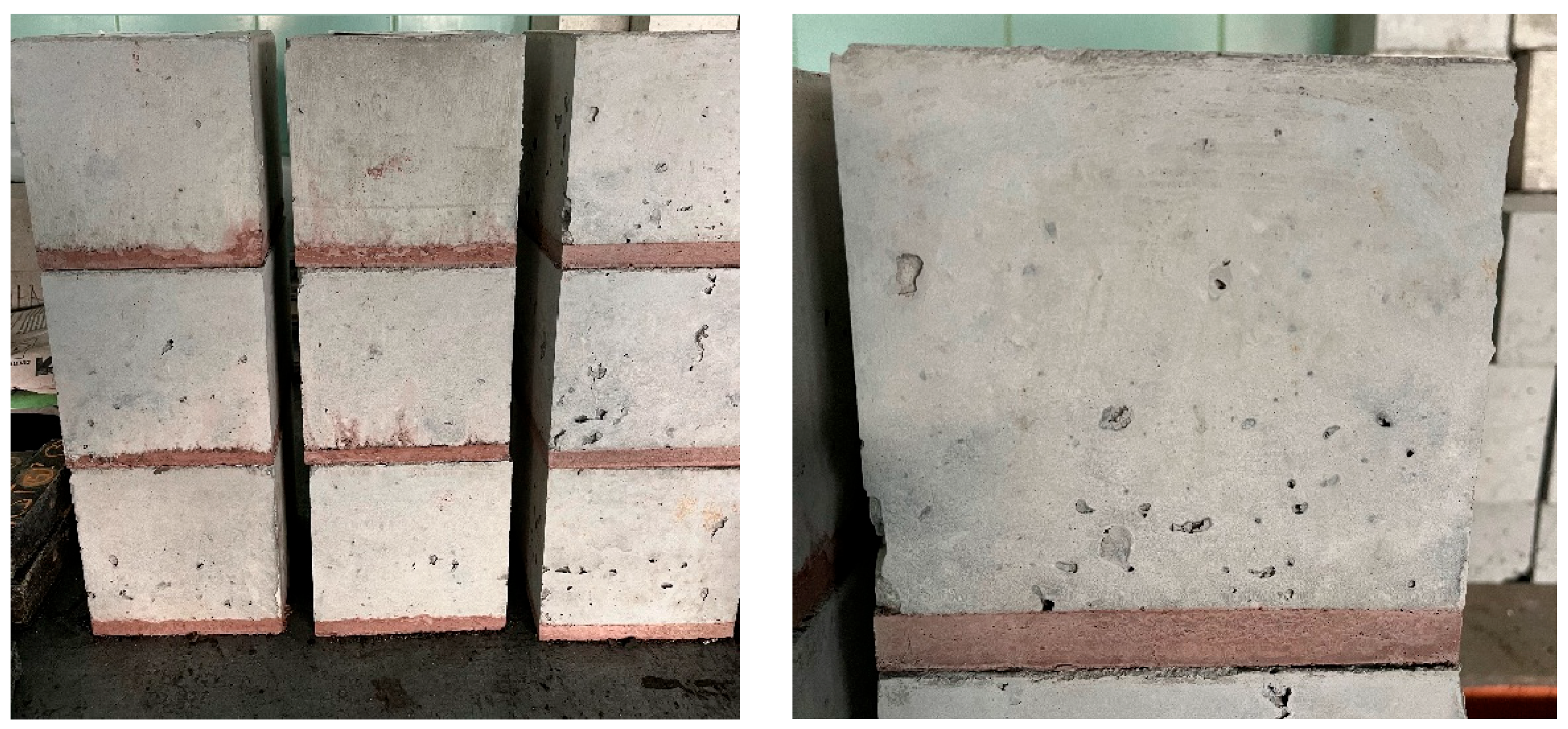
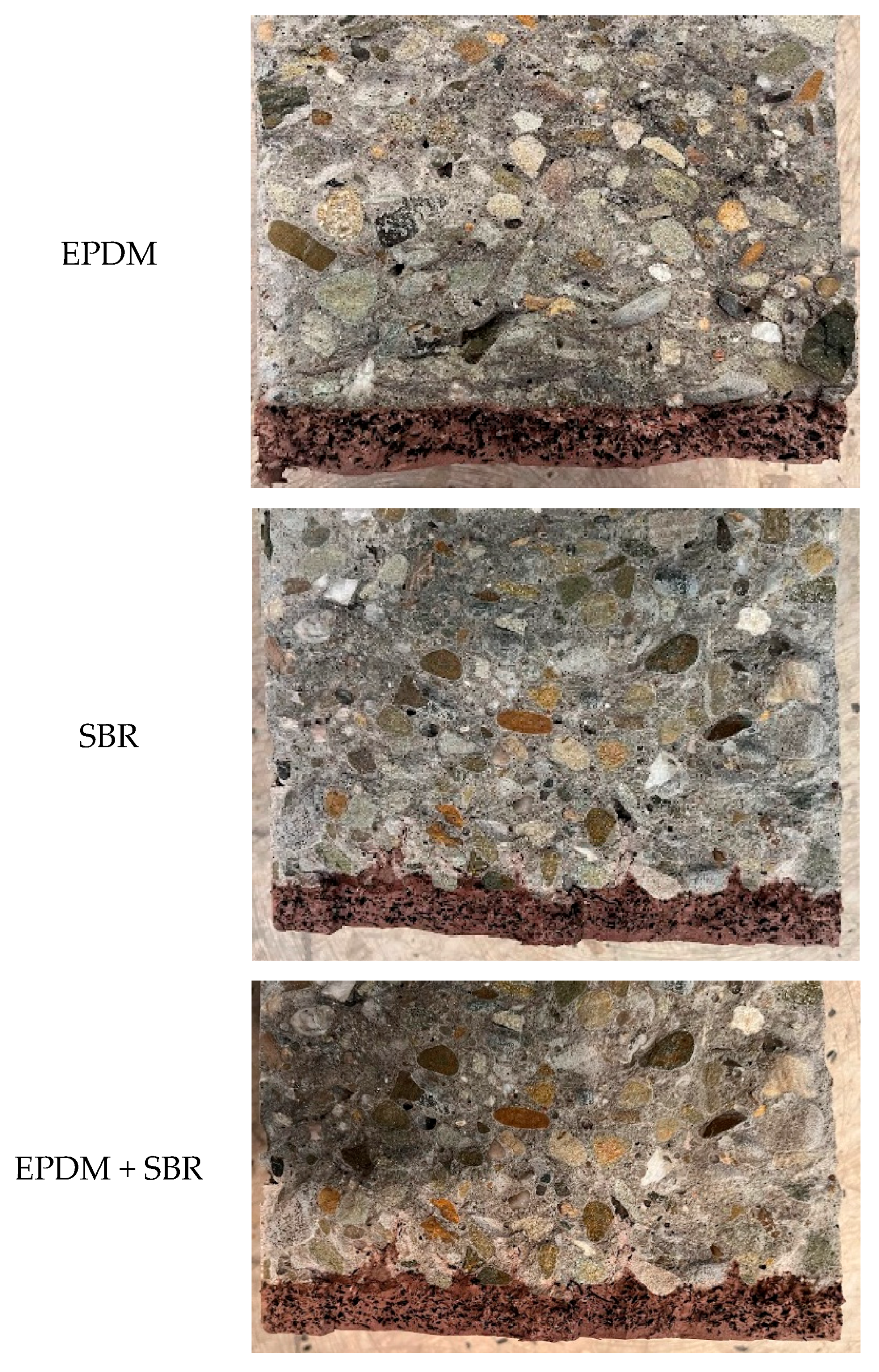
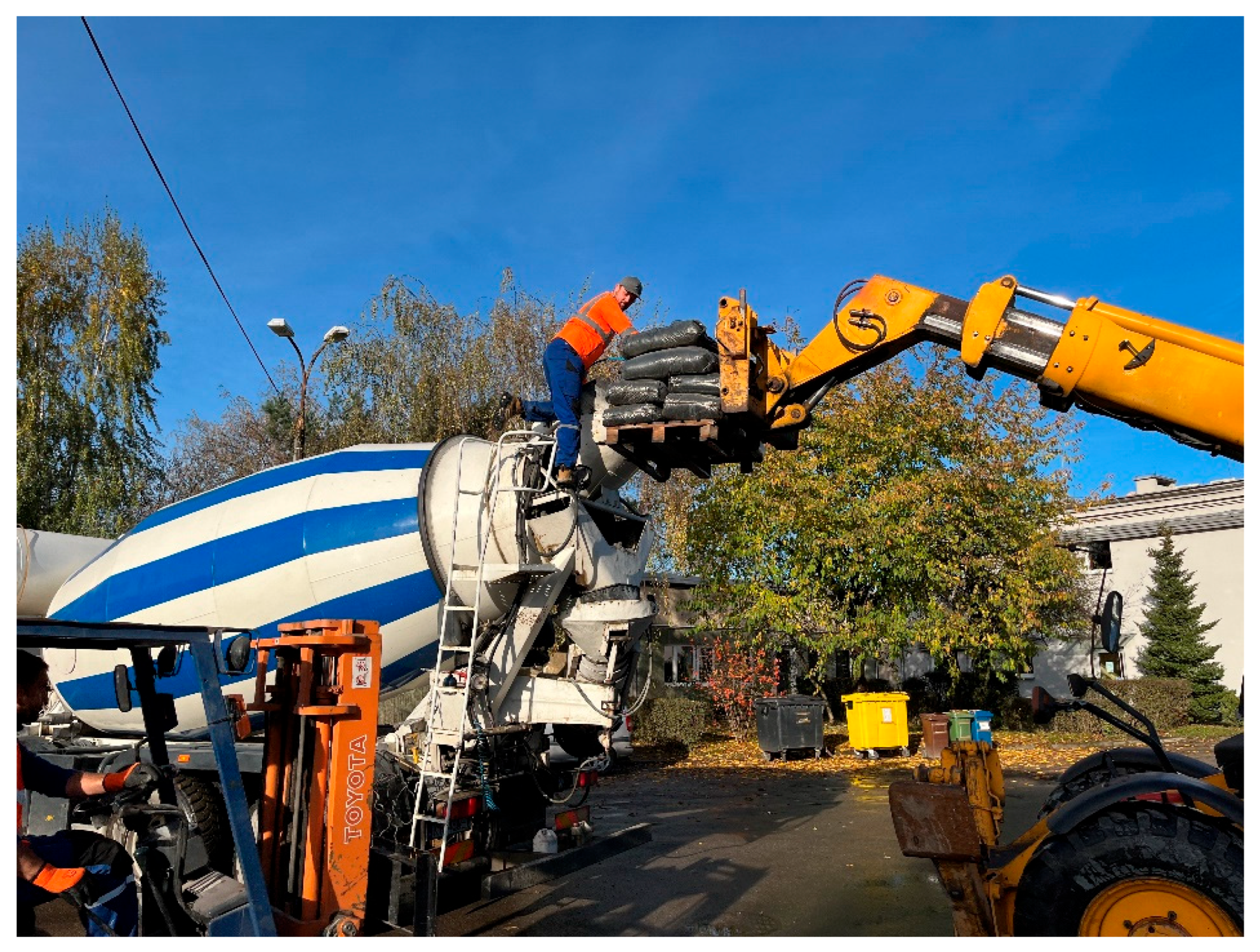

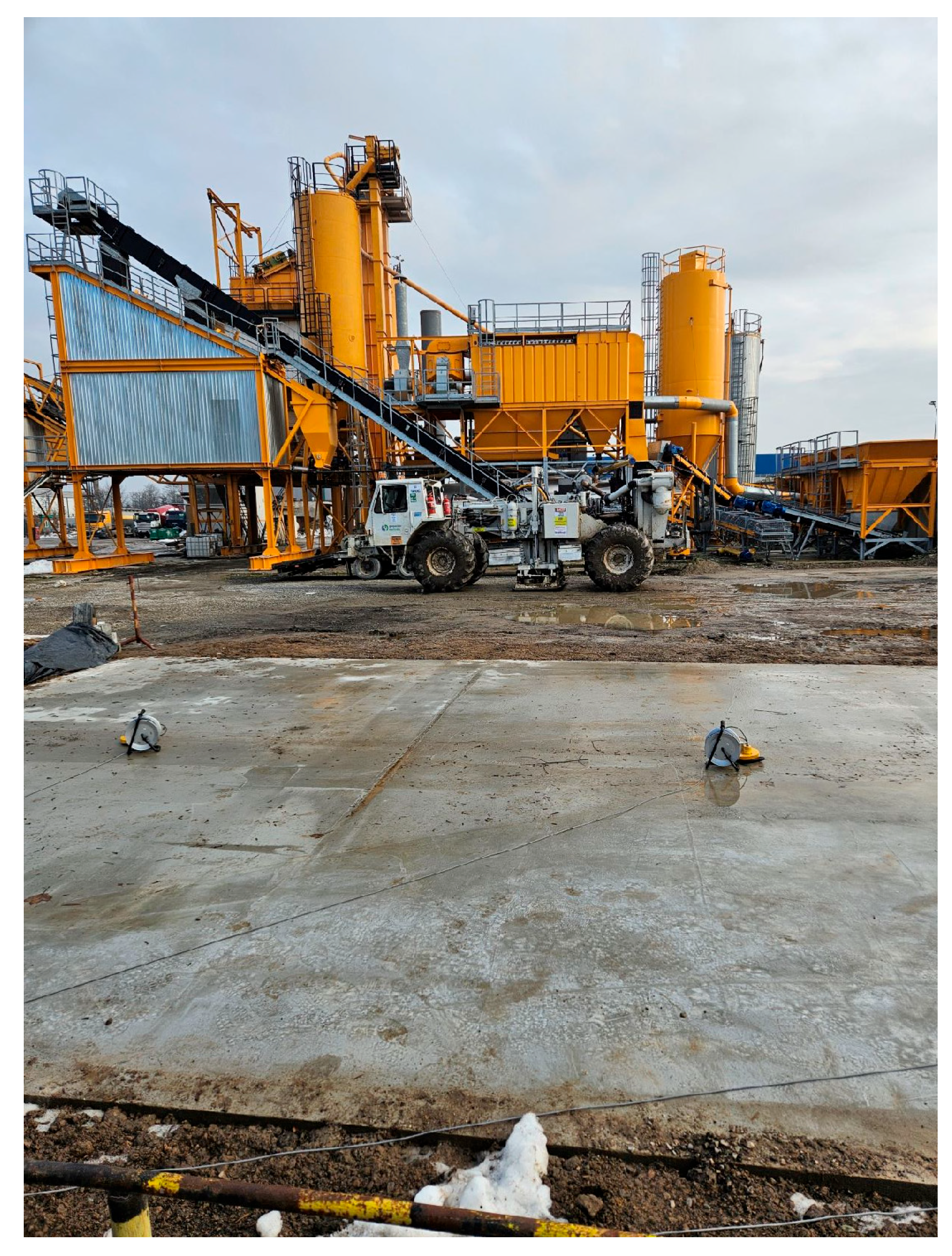

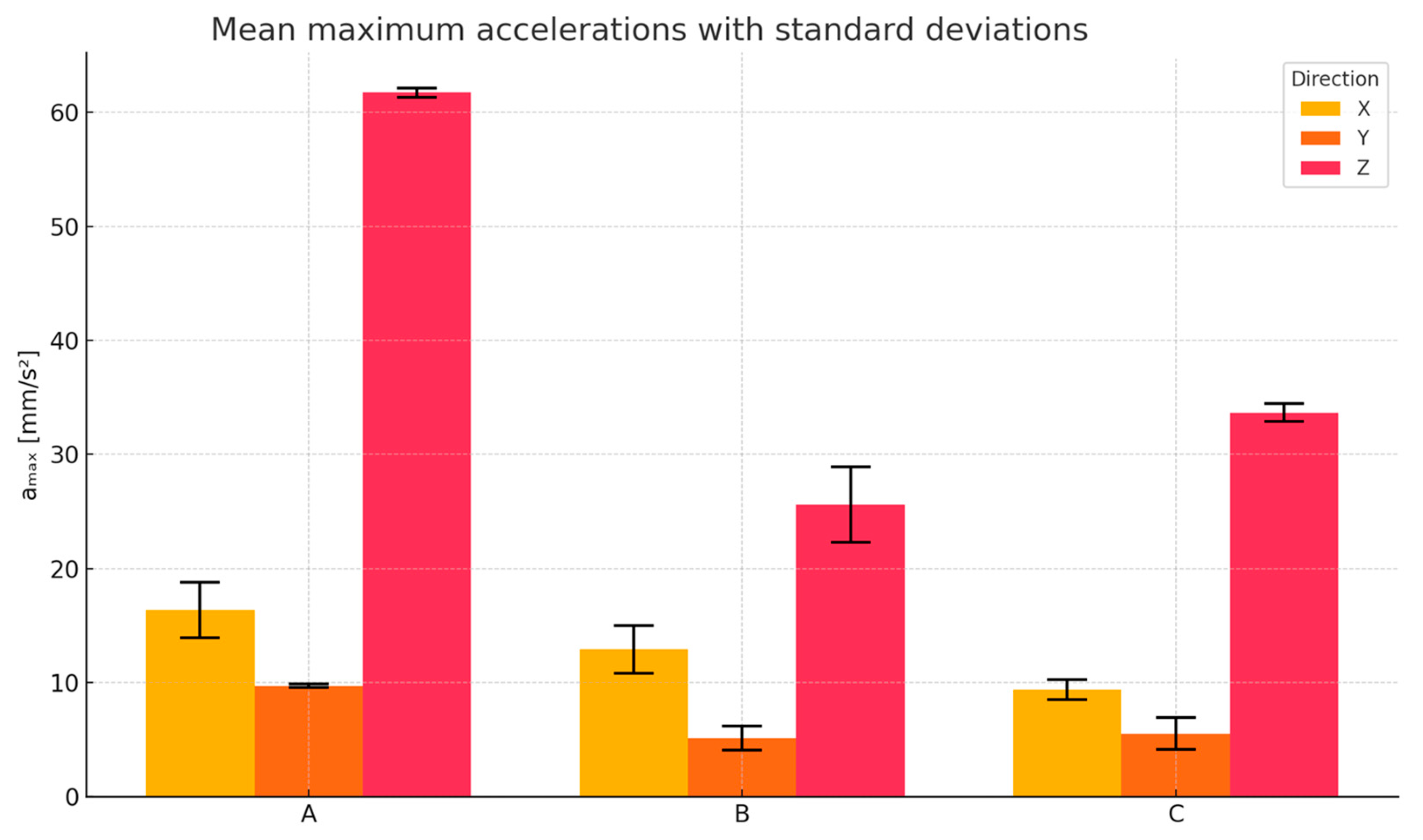
| Component | Type/Description | Quantity [kg/m3] |
|---|---|---|
| Binder | CEM III/A 42.5 N | 450 |
| Siliceous fly ash (Category A) | 150 | |
| Water | - | 250 |
| Aggregate | Sand 0/2 mm | 950 |
| Gravel 2/8 mm | 475 | |
| Chemical admixture | Polycarboxylate ether (PCC) | 3.8 |
| Water-to-binder ratio (w/b) | 0.50 | |
| Fresh concrete density [kg/m3] | 2278 | |
| Sand point (percentage of fine aggregate) [%] | 40.7 | |
| Consistency | Density [kg/m3] | |||
|---|---|---|---|---|
| Slump Test Result [mm] | Flow Diameter [mm] | |||
| After 10 min | After 60 min | After 10 min | After 60 min | |
| 240 | 280 | 600 | 630 | 2260 |
| No. | After 7 days | After 28 days | Concrete | ||||
|---|---|---|---|---|---|---|---|
| Failure Load Fi [kN] | Strength fci [N/mm2] | Mean Value fcm [N/mm2] | Failure Load Fi [kN] | Strength fci [N/mm2] | Mean Value fcm [N/mm2] | ||
| 1. | 216 | 21.6 | 21.7 | 444 | 44.4 | 44.2 | C25/30 |
| 2. | 212 | 21.2 | 439 | 43.9 | |||
| 3. | 222 | 22.2 | 442 | 44.2 | |||
| Additive Type | Dosage [% of Aggregate Fraction] | Slump [mm] After 10 min | Slump [mm] After 60 min | Viscosity Class (t500) |
|---|---|---|---|---|
| EPDM rubber granulates, 1/3 mm | 30 | 220 | 260 | VS1 |
| 60 | 200 | 245 | VS1 | |
| 100 | 210 | 265 | VS1 | |
| SBR rubber granulates, 0.8/2 mm | 30 | 180 | 200 | VS1 |
| 60 | 195 | 215 | VS1 | |
| 100 | 185 | 200 | VS1 |
| Additive Type | Dosage | Compressive Strength [MPa] After 7 days | Compressive Strength [MPa] After 28 days |
|---|---|---|---|
| EPDM rubber granulates, 1/3 mm | 30 | 7.4 | 20.1 |
| 60 | 5.8 | 18.4 | |
| 100 | 4.9 | 16.4 | |
| SBR rubber granulates, 0.8/2 mm | 30 | 6.1 | 18.7 |
| 60 | 5.4 | 15.4 | |
| 100 | 5.0 | 15.8 |
| Mix Symbol | Component | Quantity [kg/m3] |
|---|---|---|
| EPDM | CEM III/A 42.5 N | 470 |
| Fly ash | 375 | |
| EPDM rubber granulates (1/3 mm) | 410 | |
| Water | 425 | |
| PCC admixture | 5.0 | |
| SBR | CEM III/A 42.5 N | 470 |
| Fly ash | 378 | |
| SBR rubber granulates (0.8/2 mm) | 275 | |
| Water | 462 | |
| PCC admixture | 3.8 | |
| EPDM + SBR | CEM III/A 42.5 N | 445 |
| Fly ash | 365 | |
| EPDM rubber granulates (1/3 mm) | 175 | |
| SBR rubber granulates (0.8/2 mm) | 175 | |
| Water | 445 | |
| PCC admixture | 5.2 |
| Mix Type | Slump Flow [mm] | Compressive Strength | |||||
|---|---|---|---|---|---|---|---|
| No. | After 7 Days | After 28 Days | |||||
| After 10 min | After 60 min | Strength | Mean | Strength | Mean | ||
| fci [N/mm2] | fcm [N/mm2] | fci [N/mm2] | fcm [N/mm2] | ||||
| EPDM | 280 | 290 | 1. | 4.8 | 4.7 | 16.0 | 15.3 |
| 2. | 5.1 | 15.5 | |||||
| 3. | 4.2 | 14.3 | |||||
| SBR | 260 | 275 | 1. | 3.2 | 3.6 | 12.5 | 13.1 |
| 2. | 3.8 | 13.8 | |||||
| 3. | 3.7 | 13.0 | |||||
| EPDM + SBR | 285 | 290 | 1. | 5.2 | 5.2 | 17.2 | 16.5 |
| 2. | 5.4 | 15.9 | |||||
| 3. | 5.0 | 16.4 | |||||
| Mixture | No. | Schmidt Rebound Value [-] | Mean Value [-] | ||||||||
|---|---|---|---|---|---|---|---|---|---|---|---|
| No. | |||||||||||
| 1 | 2 | 3 | 4 | 5 | 6 | 7 | 8 | 9 | |||
| EPDM | 1 | 24 | 26 | 26 | 25 | 26 | 24 | 27 | 26 | 25 | 25.48 |
| 2 | 25 | 24 | 24 | 26 | 26 | 27 | 25 | 25 | 26 | ||
| 3 | 26 | 26 | 28 | 24 | 25 | 25 | 26 | 26 | 25 | ||
| SBR | 1 | 30 | 28 | 30 | 29 | 29 | 28 | 29 | 28 | 29 | 29.29 |
| 2 | 29 | 31 | 31 | 28 | 29 | 30 | 30 | 29 | 29 | ||
| 3 | 27 | 28 | 30 | 30 | 31 | 29 | 30 | 30 | 30 | ||
| EPDM + SBR | 1 | 26 | 26 | 27 | 24 | 25 | 26 | 25 | 24 | 25 | 25.41 |
| 2 | 25 | 26 | 26 | 25 | 24 | 27 | 25 | 25 | 26 | ||
| 3 | 26 | 28 | 25 | 25 | 25 | 26 | 24 | 25 | 25 | ||
| Component Type | Component | Quantity [kg/m3] or [dm3/m3] |
|---|---|---|
| Binder | CEM III/A 42.5 N | 400 |
| Fly ash | 70 | |
| Water | – | 180 |
| Aggregate | Sand 0/2 mm | 720 |
| Gravel 2/8 mm | 340 | |
| Gravel 8/16 mm | 530 | |
| Chemical admixture | PCC (polycarboxylate ether) | 4.95 |
| Water/cement ratio | 0.42 | |
| Fresh concrete density | 2285 kg/m3 | |
| Sand point | 41.6% | |
| Paste volume | 345 dm3/m3 | |
| Mortar volume | 617 dm3/m3 | |
| Fine particles ≤ 0.125 mm | 480 kg/m3 |
| Curing time [days] | 7 | 28 | 56 | 90 | Concrete class (EN 206) |
| Strength [MPa] | 29.2 | 49.6 | 51.6 | 56.2 | C40/50 |
| Standard deviation [±MPa] | 2.1 | 2.9 | 2.8 | 2.9 |
| Slump [mm] | Flow Spread [mm] (10 min) | Flow Spread [mm] (60 min) | Density [kg/m3] |
|---|---|---|---|
| 255 | 610 | 635 | 2260 |
| Curing time [days] | 7 | 28 | 56 | 90 | Concrete class (EN 206) |
| Strength [MPa] | 9.0 | 20.6 | 23.6 | 26.2 | C16/20 |
| Standard deviation [±MPa] | 2.1 | 2.5 | 2.4 | 2.7 |
| Mix Symbol | Component | Quantity [kg/m3] |
|---|---|---|
| EPDM | CEM III/A 42.5 N | 450 |
| Fly ash | 395 | |
| EPDM rubber granulates (1/3 mm) | 410 | |
| Water | 425 | |
| PCC admixture | 5.0 | |
| EPDM + SBR | CEM III/A 42.5 N | 450 |
| Fly ash | 375 | |
| EPDM rubber granulates (1/3 mm) | 175 | |
| SBR rubber granulates (0.8/2 mm) | 175 | |
| Water | 440 | |
| PCC admixture | 5.2 |
| Mixture | Flow Diameter [mm] | Lp. | Compressive Strength | ||||||
|---|---|---|---|---|---|---|---|---|---|
| After 7 days | After 28 days | ||||||||
| After 10 min | After 60 min | Strength fci [N/mm2] | Mean fcm [N/mm2] | Standard Deviation [±N/mm2] | Strength fci [N/mm2] | Mean fcm [N/mm2] | Standard Deviation [±N/mm2] | ||
| EPDM | 285 | 290 | 1. | 4.5 | 4.7 | 14.8 | 0.25 | ||
| 2. | 4.8 | 0.15 | 15.0 | 15.0 | |||||
| 3. | 4.7 | 15.3 | |||||||
| EPDM + SBR | 280 | 295 | 1. | 5.5 | 5.5 | 18.4 | 0.50 | ||
| 2. | 5.9 | 0.40 | 17.8 | 17.9 | |||||
| 3. | 5.1 | 17.4 | |||||||
| No. | A_X | A_Y | A_Z | B_X | B_Y | B_Z | C_X | C_Y | C_Z |
|---|---|---|---|---|---|---|---|---|---|
| 1 | 13.72 | 9.55 | 61.59 | 15.26 | 4.25 | 28.52 | 8.70 | 4.04 | 32.99 |
| 2 | 16.79 | 9.84 | 61.45 | 11.35 | 4.87 | 22.05 | 9.05 | 5.75 | 33.50 |
| 3 | 18.51 | 9.75 | 62.23 | 12.12 | 6.31 | 26.20 | 10.37 | 6.81 | 34.50 |
| Mean | 16.34 | 9.71 | 61.76 | 12.91 | 5.14 | 25.59 | 9.37 | 5.53 | 33.66 |
| Standard deviation | 2.43 | 0.15 | 0.42 | 2.07 | 1.06 | 3.28 | 0.88 | 1.40 | 0.77 |
Disclaimer/Publisher’s Note: The statements, opinions and data contained in all publications are solely those of the individual author(s) and contributor(s) and not of MDPI and/or the editor(s). MDPI and/or the editor(s) disclaim responsibility for any injury to people or property resulting from any ideas, methods, instructions or products referred to in the content. |
© 2025 by the authors. Licensee MDPI, Basel, Switzerland. This article is an open access article distributed under the terms and conditions of the Creative Commons Attribution (CC BY) license (https://creativecommons.org/licenses/by/4.0/).
Share and Cite
Gruszczyński, M.; Kowalska-Koczwara, A.; Tatara, T. Effect of Rubber Granulate Content on the Compressive Strength of Concrete for Industrial Vibration-Isolating Floors. Materials 2025, 18, 3134. https://doi.org/10.3390/ma18133134
Gruszczyński M, Kowalska-Koczwara A, Tatara T. Effect of Rubber Granulate Content on the Compressive Strength of Concrete for Industrial Vibration-Isolating Floors. Materials. 2025; 18(13):3134. https://doi.org/10.3390/ma18133134
Chicago/Turabian StyleGruszczyński, Maciej, Alicja Kowalska-Koczwara, and Tadeusz Tatara. 2025. "Effect of Rubber Granulate Content on the Compressive Strength of Concrete for Industrial Vibration-Isolating Floors" Materials 18, no. 13: 3134. https://doi.org/10.3390/ma18133134
APA StyleGruszczyński, M., Kowalska-Koczwara, A., & Tatara, T. (2025). Effect of Rubber Granulate Content on the Compressive Strength of Concrete for Industrial Vibration-Isolating Floors. Materials, 18(13), 3134. https://doi.org/10.3390/ma18133134








